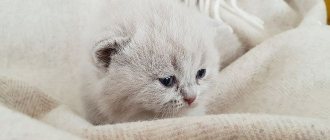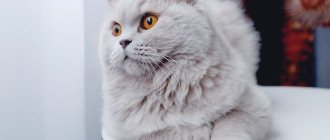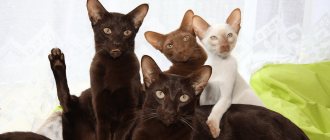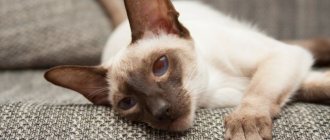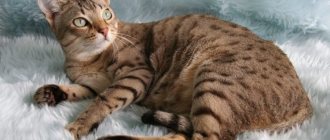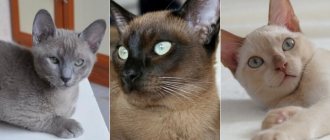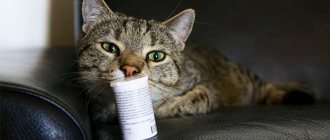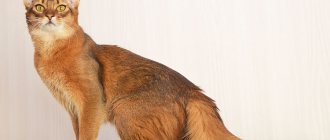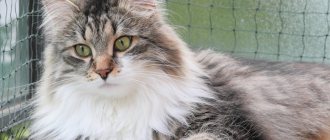The Elf cat is an original breed for lovers of hairless cats, the number of which is constantly growing every year. Along with the well-known Canadian Sphynx, new breeds are appearing, even more interesting in appearance.
The elf's calling card and its main difference from other hairless cats is the shape of its ears. Their tips are curved back, which gives the cat the appearance of a fabulous mythical creature from the Celtic epics. It is for this feature that the breed got its name.
The history of the elf breed
The Elf is a breed of hypoallergenic hairless cats with an unusual appearance. The elf breed appeared quite recently and immediately won the hearts of domestic cat lovers. America is the homeland of elves.
elf is one of the youngest breeds
The unusual breed was bred by American breeder Kristen Lead. The breeding of such cats was planned. The fact is that Kristen’s beloved cat, the Canadian Sphynx, died. It was hard for the woman to come to terms with the loss, but she understood that the Sphynx breed is predisposed to a number of serious genetic diseases, so the idea was to create a cat with a similar appearance, but with better health.
The parents of the first elves were the Canadian Sphynx and the American Curl. Karen Nelson became the breeder's partner in this difficult matter. Several attempts were unsuccessful, but hard work and the desire to breed a new breed did their job. The kittens that were born looked like fairy-tale characters - elves, hence the name of the breed. Hybrids were evaluated at TICA shows in 2006, however, they have so far been registered only as an experimental breed (2007).
The characteristics of elves have not been fully studied, so many international associations of felinologists cannot recognize this breed. But this does not prevent elves from gaining popularity among amateurs and professionals involved in raising cats. There are still few nurseries in Russia where elves are kept and bred, so most people who want to purchase a magical kitten are forced to turn to nurseries in the United States.
Description of elves
Elves, like their descendants the sphinxes, evoke conflicting impressions in people. Some people are delighted with the hairless creature, comparing it to a figurine, while others are scared or don’t know how to react. But in order to draw correct conclusions about the breed and appreciate its representatives, you need to delve into the features of the appearance and character of cats.
elves are one of the most unusual breeds
Hairless cats seem to be from another planet! They look completely different from the usual fluffies. And they behave proudly, too stately. Some of them are real freaks, and some are very nice.
Julia, site visitor
https://vseotzyvy.ru/item/6643/reviews-sfinks-lyisaya-koshka/
Appearance of elf cats
Elves have a thin but graceful body. They are strong and flexible. Due to the lack of hair, the ribs are clearly visible (especially on the voluminous chest). The back line is curved, the neck is long and graceful (the bend is clearly visible). The belly of the descendants of sphinxes is convex, which is why the body takes on a pear-shaped shape (the back of the body looks heavier than the front). However, elves are by no means lightweights. For all their elegance, they can reach 8 kg.
Almost any photograph of an elf shows his slender figure with a bulging chest
This cat's tail is not particularly long, but its smoothness makes it look like a whip. The limbs are muscular and developed, thanks to which elves can move very quickly. The forelimbs seem to be pressed to the body, the hind limbs are much longer than the front ones. Because of this feature, elves “sneak, not walk.” The paws are round in shape and look large relative to the body.
Elves have a wedge-shaped head with clearly visible cheekbones. The bridge of the nose is wide, like the nose. The ears are wide at the bottom, and the tips are pointed and curved back. It is this ear shape that is mandatory when determining the breed.
The eyes of a fairy cat are slightly convex and almond-shaped. Thanks to this combination, the elf's gaze seems expressive. Eye color - blue or green. In addition, elves can have odd eyes. Another distinctive feature of the breed is its “wrinkled” skin. The leather itself is smooth, but its surface has a “grainy” effect, so when touched, the skin seems velvety, plush. The possibility of the presence of fur cannot be ruled out (it can be in small quantities on the paws, tail and tips of the ears).
The elf's color can be almost anything: from white to almost black. Moreover, there were elves with the color-point effect. The presence of spots in the color of these cats is acceptable.
Photo gallery: elves of different colors
the lightest color of elves is white
non-cat elves have dark areas against a light main background (ears, nose, tail and paws)
elves can be with large spots or tortie color (tortoiseshell or marbled)
light elves can be heterochromic (one eye is green, the other is blue)
the delicate colors of elves include all shades of beige and sand
the darkest elf can be pure chocolate or black
Character of elves
Elves are affectionate, gentle cats who love their owners immensely. They adore family members and ask for the same in return. A fairytale cat can follow its owner around to get a portion of attention and affection. Elves love small children. Even if a child offends a cat, she will not hit him or scratch him, but will continue to love him.
Unusual cats love to communicate with any other pets, including dogs. If the animal ignores the cat's interest, it will not leave, as most cats do, but will try to attract attention to itself. Elves fit well into large families with children. Since the cat will suffer alone if the owner leaves home for a long time. You can even leave such a pet with a child, because the elf does not divide family members into “favorites” and “not favorites.” For an elf, everyone is equal.
Long-eared kittens will be real tomboys, but with age the ardor will subside, and it will be replaced by submissive devotion and love for humans. However, elves are considered intellectuals. There are both pros and cons to this. The elf's strong trait is cleanliness and discipline - he quickly gets accustomed to the litter box, understands a person's intonation and remembers the house rules (prohibitions). The downside is that, having a good memory, the elf may not forget the insult. Moreover, this will not necessarily result in revenge on the part of the cat, but it may lower the authority of the offender in the eyes of the pet. With a kind and caring attitude from the owner, this character trait will not manifest itself.
Appearance
Elves have a distinct personality: representatives of this breed are difficult to confuse with other cats.
Body type
Elves have the following characteristics:
- The weight of males reaches 7–8 kg, females – 5–6 kg.
- The body is muscular, lean, with a convex belly, giving the body a pear shape. The chest is wide and round. The tail is long, thin, and the tip is pointed.
- The limbs are slender and strong. The pads are round and wide. The forelegs of elves are noticeably longer than those of sphinxes, which gives their gait softness and insinuation. Elbows are pulled back and pressed to the body.
- The neck is long, graceful, and arched.
- The head is wedge-shaped, pointed towards the chin, with pronounced cheekbones. The nose is straight, there is a small dent on the bridge of the nose.
- The ears are large, wide at the base, smoothly curved back. The tips are pointed. The stable cartilage should be at least a third of the length of the ear. The tilt angle is allowed from 90 to 180 degrees.
- The eyes are large, almond-shaped, slightly protruding. They are yellow, blue or green. Among elves there are often individuals with eyes of different colors. Vibrissae and eyebrows are short or absent.
- The skin is hot, thick, mostly bare, with a slightly noticeable grain, and feels like suede to the touch. The folds are most pronounced around the muzzle, on the head between the ears, near the shoulders. Short hairs (no more than 2 mm) can be on the bridge of the nose, outside of the ears, paws, tail and scrotum. Wool is most often found in first-generation elves, that is, in kittens born from the mating of Sphynxes and Curls.
Color
For elves, any skin color is allowed. Most often it is beige or light gray. There are also white and black individuals. Contrasting spots may be present on any part of the body.
Elves can have spots of any shape on their skin.
Flaws
Ears play an important role in assessing the appearance of elves. It is considered a fault if they are set too high, have almost no bend, or, on the contrary, are lowered so far back that the tips touch the head or back. Their edges should not be rounded or grooved.
Other breed faults:
- abundant hairiness of the body, a large amount of hair above the ankles;
- the case is too fragile or massive;
- a small number of skin folds on the head;
- narrow head or straight profile;
- deformed or twisted tail.
Photo gallery: elf cats
Elves prefer to spend the night next to their owners
Elves are easily recognized by their curled ears and characteristic muzzle shape.
Representatives of this breed love warm beds
Elves get along well with each other and with other animals
Features of buying an elf kitten
If someone likes a certain breed of cat, he will try to find a kitten. Some people are lucky and find the kittens they need quickly, but in the case of an elf this will not happen. It is unlikely that anyone will give you a representative of one of the rarest and most expensive breeds. You will have to look for such a cat yourself. There are only a few nurseries in Russia specializing specifically in elves. Of course, you can try calling breeders who deal with Sphynxes (the number can be found on the Internet). But Sphynxes are already a popular and well-known breed that is in demand, and where there is demand, there is supply.
Buying a little elf in a short time is an almost impossible desire
Usually elves are ordered from the USA (the main part of the breed is located there). However, buying a cat, as they say, from the manufacturer does not mean a low price. The most budget option for an elf can cost you 60,000 rubles. More standard kittens cost from 150,000 rubles and above. In general, the price of an elf depends on the age, gender and even color of the animal. As soon as the breed gains popularity among Russian cat breeders, the price of such animals may change. This is a lot of money, so in case of prepayment you need to ask the seller for a receipt or agreement, and also keep the receipts.
How to choose correctly
If the future owner of the elf trusts the breeder, then he will not have to think about whether the kitten meets the characteristics of the breed. But usually, the more expensive a purchase is, the more attention we pay to the details. Buying a purebred kitten is not a luxury, but acquiring a little friend who will live next to the owner for not 5 or 10 years. Therefore, you need to choose a kitten carefully and carefully.
a candidate for pets must be absolutely healthy
If you have the opportunity to examine the kitten before purchasing, make sure that everything is in order with its health:
- ears, eyes and nose should be clean;
- there should be no wounds or bite marks on the kitten’s body (small scratches may occur if there are his brothers next to the cat);
- the animal must be active and inquisitive;
- There should be no aggression on the part of the kitten.
These are external indicators of health. In addition, the elf must have a veterinary passport with vaccinations.
If you choose a pet abroad (or it is being brought from abroad), then this may be a document in English. Even if you have difficulty translating, pay attention to the photo of the animal (on the first page) and the vaccination sheet. Opposite each mark there must be a veterinarian’s signature and seal. It is important to remember that upon arrival home you should immediately contact a veterinarian to check the vaccinations already performed. If any vaccination is missing, the veterinarian can take control of it (and if necessary, carry out revaccination).
To avoid buying a kitten of another breed (for example, a sphinx) instead of an elf, pay attention to the characteristics of the breed. The body should be slender, wrinkled and without hair, the tummy should be convex and soft. Examine the ears - their tips should be turned back. A real elf can be born with straight ears (like a sphinx), but such a pet will not be allowed for exhibitions or breeding. But most often, elf cats give birth to kittens with straight ears if the father of the offspring is a Canadian Sphynx. Breeders practice this, so if there are babies with straight ears in the litter, it is better to refrain from purchasing and find another nursery. In any case, the breeder must give you the kitten's pedigree (the parents of the baby must be indicated in it).
Video: what a newborn elf kitten looks like
Is it possible to adopt an elf under three months of age?
Some people, having discovered a kitten of the desired breed in some nursery, try to pick it up right away. Sometimes this desire is influenced by low cost, and sometimes by the desire to “nurse” a small warm lump. A conscientious and responsible breeder will not give away a baby under three months of age (minimum 12 weeks). A newborn cat is vulnerable, its body is exposed to attacks from viruses and infections, so it needs immunity. Primary immunity is transmitted to cats through the cat's colostrum. If you take an ordinary outbred kitten away from its mother, it may survive, but elves take more risks in this regard.
In addition to the immune system, the cat also provides education to the kittens. It is the nurse who teaches her cubs to eat, play and go to the litter box correctly. A person cannot teach a kitten the way a cat can. In addition, if you leave a baby elf without a mother, he will experience stress, which can subsequently lead to character problems.
And another important point is vaccination. Until the cat has received its first vaccinations, responsibility for its life and health should lie with the breeder. After all, no one can guarantee that the kitten will not get sick after the move. A sudden change of place of residence can already undermine the kitten’s health, and without vaccination it is deadly. Vaccination is carried out at 3 months, so if you have already chosen an elf, but he is younger than 12 weeks, then it is better for you to wait. In order not to “miss out” on the long-awaited cat, you can book it (sometimes you need to make an advance payment for this). Many nurseries (even abroad) offer such a service as booking.
Video: elf kitten in all its glory
How to choose the right kitten
The kitten must be healthy
When choosing an elf kitten, it is better to first consult with the breeder so as not to buy an outbred one.
You should not be flattered by random advertisements, but contact specialized nurseries. Although there are not many of them in Russia, since the breed is rare.
When examining your future pet, you need to pay attention to a number of points:
- absence of discharge in the eyes, ears and nose;
- there should be no damage to the skin (bites, wounds, scratches);
- the animal must be active and inquisitive;
- Display of aggression is unacceptable.
If Elf is purchased abroad or delivered from there, then the accompanying documentation may be written in English. If you have any difficulties with translation, it is recommended to look at the photo on the first page and the list of vaccinations with the veterinarian’s stamp.
Contents of a fairytale elf cat
Due to the lack of fur on cats, elves often freeze. Moreover, they can freeze in the summer (on a cool day). Therefore, it is advisable to stock up on warm clothes for your pet even before he moves into your home. First of all, you need to prepare a cozy and warm place. The ideal option is a house with insulated walls, but a soft bed will also do. You need to install it away from the window, but so that the animal can clearly see the entire room from its place. You cannot place a bed near the radiator, as close heat can dry out the animal’s skin.
In addition to a sleeping place, the cat will need clothes: T-shirts, sweaters, overalls. You can choose your pet’s wardrobe at your own discretion, but it is advisable to provide items for all occasions. Some owners of hairless cats even buy special coats, hats and socks for cats. Cat clothes are bought not only to take beautiful photographs, first of all, these are things necessary to maintain the health of the pet. A budget option is to make clothes for your cat with your own hands.
My cat has fur, but she still gets cold sometimes (you can tell by the shivering). For walking outside, we have several vests that I made myself. The only difficult thing was to accustom her to things. So that she would not resist, I put the vest on her several times a day for 5 minutes and went out to the balcony with her. The cat is used to the vest being a walk. Now, for us to go out for a walk, she sits down next to her vest and waits.
Photo gallery: clothing options for a hairless cat
For walks on summer evenings, outfits made of fine knitwear are suitable
For everyday walks, a knitted sweater or vest is suitable
for walks in the winter, you need warm overalls or a coat
in winter, knitted or knitted sweaters that cover the back and stomach are useful
socks for cats are made in the form of mittens, but with anti-slip soles
home clothes for a cat can be a robe-overall
Nutrition
To feed the elf you need three bowls. One deep plate is needed for water, and the other two are for food. It is better to purchase ceramic or metal dishes. Plastic dishes wear out quickly, and a rough surface can become a breeding ground for bacteria. There should be constant water in the bowl (the liquid should be filtered and at room temperature). With food it’s a little more complicated. Cats can be fed commercially prepared food or natural food. In the first case, in order not to get confused when choosing food, check with the breeder what your kitten was fed. Try to find the same food. The ideal option is dry food. It is already balanced exactly as needed and beneficial for the cat.
When feeding naturally, you need to take into account that the food should be rich in proteins, carbohydrates and fiber. Most elves are gluttons, they eat quickly, swallowing food almost without chewing. At the same time, they love new products, as curiosity takes precedence over caution. Therefore, the menu should be varied. Meat should be the basis of the diet. It should be lean meat, such as beef.
Elf diet
Food for the elf can be prepared from the following products:
- beef, chicken giblets and raw chicken meat, turkey meat (can be finely chopped or minced, be sure to remove the bones;
- steamed fish (salmon, cod) in the form of boneless fillets, raw seafood;
- eggs (an adult cat can be given 1 boiled yolk (preferably quail than chicken);
- dairy products (milk is not recommended, but cottage cheese, kefir, yogurt and unsweetened yogurt are acceptable);
- cereals and grains (oatmeal, buckwheat, rice);
- fruits and vegetables (carrots, white cabbage, apples, greens).
An additional source of vitamins will be grass grown on the windowsill. Seeds of such grass can be bought at any pet store. In addition to vitamins, it contains a lot of fiber, which is very beneficial for the digestive system of cats.
when feeding an elf naturally, preference should be given to meat products
When I first bought this grass, I thought that the cat would refuse. After all, she doesn’t eat grass outside, and she’s not interested in house flowers either. But as soon as you showed her this grass, plucking the leaves became the cat’s favorite pastime. Animals cannot bite off a piece of the sprout (like people who eat the feathers of green onions), but they can pinch off. My cat picks off each sprout and tastes it. Those that seem suitable to her, she chews and swallows appetizingly, and those that she doesn’t like, she spits out.
You also need to remember the list of foods that should not be given to elves:
- chicken and fish bones (cat may choke);
- pork, goose, duck (they can be infected with worms, moreover, such meat is a fatty product);
- smoked, fatty, spicy and salty foods;
- sweets (chocolate can cause poisoning, sweets are dangerous due to allergies, and in general, sweets spoil cats’ teeth);
- potatoes (starch is not digested by cats' intestines and can cause high blood sugar levels);
- legumes (not digestible by cats);
- salt and spices;
- medicines and vitamins that are intended for people.
the elves will decide for themselves which vegetable or fruit they like
You can make yourself a reminder that will indicate which foods and in what quantity should be included in your elf’s diet:
- raw beef or veal, previously frozen - 110–130 grams per day;
- Boiled chicken meat without bones - about 3 times a week;
- meat by-products (chicken or beef liver, also heart, lungs and kidneys, raw after freezing or boiled) up to 2-3 times a week (liver no more than 1 time a week);
- boiled fish no more than 2 times a week;
- egg yolk (raw or boiled) 1-2 times a week;
- fermented milk products 2-3 times a week;
- cereals up to 3 times a week;
- vegetables (boiled or raw) can be given as much as the cat wants.
How many times a day does an elf eat?
Since elves eat quickly, they can overeat, so you need to strictly control the portion size. It is advisable to feed the cat a little, but several times a day. If other adult cats can have breakfast and dinner, then the elf can be fed 3-4 times a day. Kittens are fed a little more often - up to 5 times a day. In general, the frequency and volume of feedings depend on the cat itself. A healthy, energetic teenage cat needs more nutrients than an older, calm, weak animal.
I heard that elves are similar to sphinxes in their habits. And I saw how the sphinx eats. He had a wide plate (20 centimeters in diameter) full of dry food. The cat had just been brought home from a walk and he was very hungry. He sat down near the bowl and began to eat, scooping up food with his mouth wide open (like an excavator bucket). From the outside it looked like he could fit half a glass of food in his mouth at a time, and he swallowed his “yummy” almost immediately. I would advise elf owners to divide even 1 feeding into several parts (add food as they are eaten). In the end, in such a hurry, the cat may choke. In addition, having quickly swallowed all the food, the animal will not understand that it has just been fed, and will ask for more.
it is important to control not only the cat’s diet, but also the eating process itself
How to care for an elf's appearance
To care for an unusual pet you will need the following tools and supplies:
- cotton swabs and Vaseline;
- cat toothpaste and a small toothbrush;
- cotton pads;
- nail clipper and scratching post;
- first aid kit (iodine, brilliant green, bandage, cotton wool, plaster, etc.);
- cat shampoo;
- towel.
Elves, like other hairless cats, need special care, so you need to examine your pet more often. The ears and eyes of such a cat need to be examined every day. If discharge accumulates in the corners of the eyes, they should be removed with a cotton swab dipped in clean water or a tea solution. If dirt or wax has accumulated in your ears, you can remove all excess with a cotton swab. You need to be extremely careful here. The skin of animals is very delicate, and the cotton wool can separate from the plastic stick and harm the pet. Therefore, it is better to first lubricate a cotton swab with Vaseline or other oil.
The elf's teeth should be brushed with a small brush and toothpaste intended for cats. This is a complex procedure, so it is not necessary to carry it out every day, but you need to monitor the condition of the animal’s oral cavity (especially with natural feeding). The recommended frequency of the procedure is once a month.
caring for an elf's appearance requires special attention
Elf cats cannot be called hyperactive, they will not spend hours scratching, so sometimes they will need to trim their claws. You only need to cut off the very tip of the claw (no more than 2 millimeters). If your elf is often busy with a scratching post, then his claws are already in good condition and do not need to be trimmed. In case of unsuccessful procedure (if you cut off too much and started bleeding), you should have a first aid kit. A bleeding wound should be treated with brilliant green.
Should you bathe your elf?
If there is no need to brush your cat’s hair, this does not mean that there is no need to bathe it. In this regard, elves are similar to people. The fact is that usually only the pads of cats' paws sweat. Nature has made it so that a cat can mark its territory through the moisture on its paws, leaving scent marks (even if a person does not smell this smell). But elves are a completely different matter. Hairless cats have a fast metabolism, this is necessary so that the cat does not freeze. Therefore, the skin of such pets secretes sweat. Of course, you don’t need to bathe your pet every day, but wiping it with a damp cloth is quite possible. A full bath day can be arranged, for example, once a month. The water procedure must be carried out in several steps:
- Fill up with warm water (in a basin or bathtub) to approximately 20 cm.
- Place a towel or a special anti-slip mat on the bottom.
- Lower the cat into the water so that it stands on the bottom with its back paws (its front paws can hold on to you or the edge of the bath).
- Wet the animal's body, including the neck and head (do not get any water into the ears or nose).
- You can wet the cat's face and wipe it with your palm.
- Apply some shampoo to your cat's withers.
- Distribute the shampoo over your entire body, except your head, and then rinse gently from the shower head.
- Wrap the cat in a towel and pat its body dry (use a second towel if necessary).
- After bathing, the cat can be dressed in something warm.
Elves need to be bathed often, but carefully
Care and maintenance
Like all hairless cats, elves require careful grooming. Take care of your pet's bed. A specially equipped house is best suited. Avoid drafts: porridge can easily catch a cold.
Stock up on clothes for your naked cat. It may be needed not only for street walks, but also for home use. If you feel that your house is cool, then your pet also needs to be dressed up.
Elf cats respond adequately to walks and over time may even ask to go for a walk with them. Walk your pet on a harness and avoid direct sunlight so that the delicate dog does not get burned.
Due to the lack of fur, the animal's body secretes a lubricant that can leave greasy marks. It is recommended to wipe cats daily with wipes or a damp sponge. Pay special attention to skin folds. Carry out water procedures as they become dirty, but not too often (the sebaceous glands may, on the contrary, begin to secrete more lubricant). At first, your pet may not like it, but if you bathe correctly, over time the animal will get used to it and will not feel afraid. Use special shampoos for hairless cats, they are different for those that are suitable for ordinary cats. After bathing, dry the skin with a towel and, if necessary, dress your pet.
Due to the lack of eyelashes, the cat needs to wipe its eyes daily to remove dirt with a cotton sponge. Monitor the condition of your ears: clean them with a cotton pad moistened with a special lotion, which is sold in a veterinary clinic. If necessary, the nails are trimmed once a week, no more than 2mm from the edge.
Vices of the Elf Breed
Lop-eared kittens are born strong and genetically healthy. The breed is still being studied, but elf breeders claim that these cats have strong immunity. According to hybrid cat breeders, elves can live up to 18 years. Of course, such a life expectancy is only possible with proper care and a balanced diet.
The main problems of elves are the characteristic defects of all hairless cats. Hairless animals often have minor skin problems. It could be pimples or acne. This can be caused by poor diet, poor hygiene, or hormonal imbalance. Typically, certain areas of the body are covered with pimples:
- dorsal surface of the tail;
- back along the spine;
- muzzle, neck and submandibular space;
- surface of the abdomen.
Sometimes the entire body of an animal is covered with acne (for example, during puberty). There is a definite connection between the occurrence of acne and the color of the animal. Acne most often appears in blue or pink (cream) cats.
Hairless cats may develop pimples or acne
Are elves prone to diseases?
In general, the creators of the breed tried to achieve absolute health of cats. Elves have not yet been found to have a predisposition to genetic diseases, but any hairless cat can catch a cold (this is the price to pay for its unusual appearance without hair). Hairless cats do not tolerate respiratory diseases well, so you should try to avoid drafts and hypothermia. In addition, the elf’s body is not protected by a fur coat from ultraviolet rays, so if the cat stays outside for a long time, the cat may get a sunburn (for this reason, elves are usually not taken for walks).
The elf may also develop seasonal dermatitis (most often in females before or after estrus). At this time, you can contact your veterinarian to recommend medications for itching. If a cat scratches itself too much, sores may appear on its body. An infection can enter the animal's body through wounds. Veterinarians usually prescribe an injection (Dexafort) or a spray (Terramycin). However, if the itching is not severe and there are no sores, then it is better to try to avoid medications.
My friends have a hairless cat who scratches herself until she gets deep scratches (sometimes even on her face). So its owners used to use anti-scratch pads (silicone claw covers that need to be glued with instant glue). It was convenient and beautiful, but a friend began to notice that the cat was trying to tear off the pad with its teeth. As a result, they stopped using anti-scratch products. Now they are buying socks. There is a secret here: the main thing is that the socks fit the cat in size and have a thick, smooth elastic band. The cat tries to take off its sock exactly at the moment when it urgently wants to scratch something. While she is trying to take off one sock, the itching may stop and there is no need to take it off.
Elves may develop health problems from scratching their skin.
Defects in appearance
All bred elf kittens have the characteristic features of the breed, so at the moment any deviation from the breed standard can be called a defect in the appearance of an elf:
- deep-set eyes;
- Ears that are too curled or completely flat;
- legs too short, etc.
It is still difficult to say for what signs an elf cat can be disqualified from an exhibition, because strict and final standards have not yet been approved. But the basic requirements for elves are the same as for their relatives - the sphinxes. The main distinguishing feature of elves and the main characteristic of the breed are curled ears.
Interesting Facts
Many people begin to treat Elves differently after getting to know them better.
Hairless cats are like people from another planet! Elves do not look at all like typical house purrs. And they behave too importantly and proudly. Some, looking at these unusual creatures, experience tenderness, others - hostility.
But the breed is quite interesting. Here are a few excerpts worth noting:
- Elves are easy to offend (shout sharply, deprive them of attention, etc.). Of course, they are offended, but not for long. Especially if the owner realizes his mistake and immediately pets and talks to the pet.
- These representatives are absolutely not characterized by aggressive behavior. In any situation, they maintain amazing composure and are always positive.
- You cannot take a kitten away from its mother cat until it is at least 3 months old. Previously, the baby is very vulnerable to negative external factors: his immunity is so weak that he is highly susceptible to infections and viruses. And he receives initial immunity from his mother’s colostrum. Otherwise, his death is possible.
- The mother cat, while the cubs are under her care, teaches them basic skills: eating, relieving themselves in the litter box, and playing. She does this better than a human.
- This breed is prone to gluttony. It is interesting to watch them while eating food. They open their mouths wide and grab large portions, then swallow without chewing. Therefore, it is recommended to gradually add food into the bowl so that the animal does not inadvertently choke.
- Elves love new foods. Without fear, they immediately try it, as curiosity takes over.
Breeding fairy cats
Breeding elves is not that easy. Nowadays only professional breeders are engaged in breeding these cats. As a rule, this happens in nurseries where the main breeding breed is Sphynx. Most American elf nurseries breed elves with each other, and in other countries mating an elf with a sphinx is often allowed. This may be due to the fact that 2 mature individuals with folded ears are an expensive commodity. In addition, a cat can bring from 1 to 5 kittens at a time, and no one can guarantee that all the kittens will turn out exactly as they should.
Only professional breeders can breed elves competently
Elves become sexually mature at an early age (6–7 months, sometimes earlier). It is not recommended to breed a cat during her first heat, because the cat has not yet physically grown, early birth can be complicated, and kittens can be born weak. The recommended age for mating is 1–1.5 years. Despite the fact that any cat can give birth several times a year, it is not recommended to breed elves too often (the normal frequency of births is once a year or 3 times every 2 years).
How to choose a partner
It will be difficult to find a partner among house elves, because most cats of this breed fall into caring hands already neutered. A cat that can become your cat's partner can be found in a specialized nursery (for example, where you took your cat). A mature, uncastrated and healthy elf can live in another city or even country, you must be prepared for this. Most nurseries you go to will offer a Sphynx for breeding.
currently it is very difficult to find a partner for mating an elven cat
You need to decide what you want to get from the mating. If you want to continue the family line of your pet and get beautiful mestizos or you need real elves who can have a show career in the future. Mating with a Sphynx will produce mixed breeds, which may inherit weak immunity from the manufacturer. Mating with an elf will produce strong kittens, but this process will cost you more.
If you manage to find an elf, make sure that he is a real elf. He must have a veterinary passport and a pedigree (it indicates the cat’s parents). Even if both the elf’s mom and dad are the same big-eared cats, ask about the grandparents of your future partner. Of course, there is not much choice in the world of elf breeding yet, but try to find a partner with experience for your cat. It will be a shame if you go to your groom in another state and the mating fails. If everything goes well and several sleepless nights end in pregnancy for your elf, then outstanding representatives of the breed will be born from the mating. This is especially important if you plan to sell future kittens.
If the owner of the elf does not plan to get kittens from his pet, then the animal must be castrated or sterilized. This is important because sexual abstinence results in illness (sometimes fatal) for cats.
Video: castration and sterilization of cats through the eyes of a veterinarian
At what age is it recommended to have surgery?
Spaying/neutering is recommended at 9–12 months of age. Foreign veterinary clinics have long been practicing early operations, but Russian cat breeders try not to rush. Modern veterinary medicine has made great strides forward; now such operations do not harm even very young cats. Sometimes, after castration/sterilization, stitches are not even applied, since the incision remains small, it heals quickly and does not bleed (the edges of the incision can be processed with a laser).
If you have definitely decided that your pet will not (will no longer) produce offspring, then do not delay the operation. Some owners bring their cats for surgery at an advanced age, but older cats are already weak and may have difficulty withstanding anesthesia or the postoperative period. The average age at which their four-legged friends are sterilized is 1.5–2 years. The exception is cases when there are medical indications for the operation.
How to care for your cat after surgery
During the first day after surgery, the cat should be monitored. The animal recovers from anesthesia in 6–12 hours (depending on the type of anesthesia). At this time, the cat cannot coordinate in space, but tries to listen to the body. She may want to drink or go potty, but her legs won’t obey her, and the owner can help the pet. In addition, unforeseen complications may arise; in such cases, you should immediately call the veterinarian who operated on the animal.
The most difficult thing after surgery is coming out of the state of anesthesia
You need to ensure that the cat does not lick its stitches and does not remove the post-operative blanket (if any). When my cat was sterilized, the veterinary clinic gave us a blanket (it was included in the cost of the operation). The cat slept for the first few hours after returning home. Then she walked, staggering from side to side. She either tried to walk to the kitchen or crawl to the toilet, but nothing worked. I was afraid she would bump into something and hurt herself, so I moved her litter box into the room and placed her water bowl right next to the crib.
Table: pros and cons of elf cats
| Breed Features | pros | Minuses |
| Appearance | many people like the elf’s velvet back and deep, understanding look | Some people are scared by the appearance of an elf, some people just make them laugh |
| Habits and habits | elves act like dogs, literally chasing their owners, but they are affectionate, sociable and loving | the elf can be vindictive or sloppy (especially when visiting the potty) |
| Content | elves do not need to be combed and can be dressed in any cat outfits | They get very cold (especially in winter), so you need to make sure that the animal is warm |
| Health | no genetic predisposition to diseases | due to the lack of fur, the elf can catch a cold |
| Breeding | — | it is difficult to find a suitable partner; there is a risk of kittens being born with deviations from the breed standard |
| Cost of a kitten | you can buy a castrated boy for a small amount (from 10,000 rubles) | the price of beautiful elves with a pedigree can exceed 150,000 rubles |
Character
Elves are pronounced companion cats. They are friendly, sociable and affectionate, trying to spend as much time as possible with their owners, including sitting in their arms. Usually equally attached to all family members. Quite talkative. They love to be the center of attention and do not tolerate loneliness well. Patient with children. They prefer to spend the night next to their owners. They are smart, observant and curious, interested in all the activities of people and, if possible, try to take part in them. As children they love to play and be mischievous, but with age they become more sedate. They love heights.
A number of owners note the theatricality and mannerisms of these animals - they are often prone to demonstrative behavior “in public” and can be capricious due to lack of attention.
They quickly learn the rules of behavior in the house, but demand respect: these cats will certainly take revenge for rudeness and cruelty. Elves get along well with other cats and non-aggressive dogs, so if owners do not have the opportunity to devote enough time to them, buying a second animal may be a good solution.
At a young age, elves are especially active and curious.

